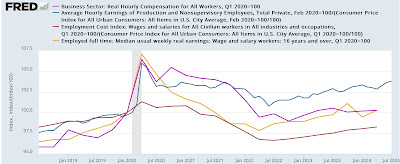– by New Deal democrat On this Labor Day, it is fitting to update the economic state of ordinary workers. There is a variety of economic data series to track both average and median wages: The most commonly known measure average hourly pay for nonsupervisory workers, which is part of the monthly jobs report. The Bureau of Labor Statistics, which conducts the household employment survey, also reports “usual weekly earnings” for full-time workers each quarter. The BLS also measures the Employment Cost Index quarterly. The BLS also measures “business sector compensation per hour” quarterly. Without further ado, here is the update for all four. Average hourly wages are updated through July; the other three are updated through the end of
Topics:
NewDealdemocrat considers the following as important: US EConomics
This could be interesting, too:
NewDealdemocrat writes JOLTS revisions from Yesterday’s Report
Bill Haskell writes The North American Automobile Industry Waits for Trump and the Gov. to Act
Bill Haskell writes Families Struggle Paying for Child Care While Working
Joel Eissenberg writes Time for Senate Dems to stand up against Trump/Musk
– by New Deal democrat
On this Labor Day, it is fitting to update the economic state of ordinary workers. There is a variety of economic data series to track both average and median wages:
- The most commonly known measure average hourly pay for nonsupervisory workers, which is part of the monthly jobs report.
- The Bureau of Labor Statistics, which conducts the household employment survey, also reports “usual weekly earnings” for full-time workers each quarter.
- The BLS also measures the Employment Cost Index quarterly.
- The BLS also measures “business sector compensation per hour” quarterly.
Without further ado, here is the update for all four. Average hourly wages are updated through July; the other three are updated through the end of Q2. All series are normed to 100 as of February 2022; the nominal series are deflated by the CPI:
It is important to keep two things in mind.
First, with the exception of the “Employment Cost Index,” which follows wages on offer for each given type of employment, all are subject to the distortion that arose from the much bigger layoffs of low wage service workers during the pandemic lockdown era than office workers. This boosted the averages, since more high wage workers were employed.
Second, all of the measures suffered from the spike in gas prices from $3 to $5 as Putin threatened, and then invaded Ukraine. After June 2022, as gas prices retreated back down towards $3 again, all of the measures benefitted.
Of the four, only one – the Employment Cost Index – is below its pre-pandemic level, down -1.7%. This is not nearly as negative as it may seem at first blush, since the Boom in job availability meant that many workers switched jobs to higher paying occupations.
That is reflected in the other three indexes. Real average hourly wages are up 3.8%. Real median usual weekly earnings and real hourly compensation are both up 0.3%.
This improvement in real earnings for workers since June 2022 is reflected in the recent increase in consumer confidence about the economy and is also reflected in the improvement in the “incumbent” political party’s prospects in November.
Happy Labor Day to all.

